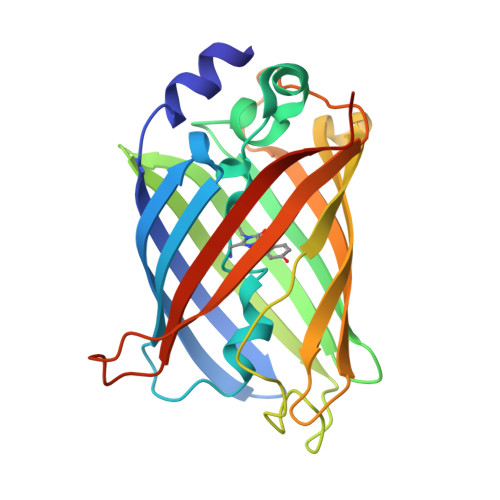Crystal Structure of Venus, a Yellow Fluorescent Protein with Improved Maturation and Reduced Environmental Sensitivity
Rekas, A., Alattia, J.R., Nagai, T., Miyawaki, A., Ikura, M.(2002) J Biological Chem 277: 50573-50578
- PubMed: 12370172
- DOI: https://doi.org/10.1074/jbc.M209524200
- Primary Citation of Related Structures:
1MYW - PubMed Abstract:
Yellow emission variants of green fluorescent protein (GFP) have been found useful in a variety of applications in biological systems due to their red-shifted emission spectrum and sensitivity to environmental parameters, such as pH and ionic strength. However, slow maturation properties and new requirements for more intense fluorescence necessitated further mutagenesis studies of these proteins. Venus, a new variant with improved maturation and brightness, as well as reduced environmental dependence, was recently developed by introducing five mutations into the well characterized variant, enhanced yellow fluorescent protein (EYFP). In this paper, we present the crystal structure of Venus at 2.2 A resolution, which enabled us to correlate its novel features with these mutation points. The rearrangement of several side chains near the chromophore, initiated by the F46L mutation, was found to improve maturation at 37 degrees C by removing steric and energetic constraints, which may hinder folding of the polypeptide chain, and by accelerating the oxidation of the Calpha-Cbeta bond of Tyr(66) during chromophore formation. M153T, V163A, and S175G were also found to improve the rate of maturation by creating regions of greater flexibility. F64L induced large conformational changes in the molecule, leading to the removal of halide sensitivity by preventing ion access to the binding site.
Organizational Affiliation:
Division of Molecular and Structural Biology, Ontario Cancer Institute and Department of Medical Biophysics, University of Toronto, Toronto, Ontario M5G 2M9, Canada.



















